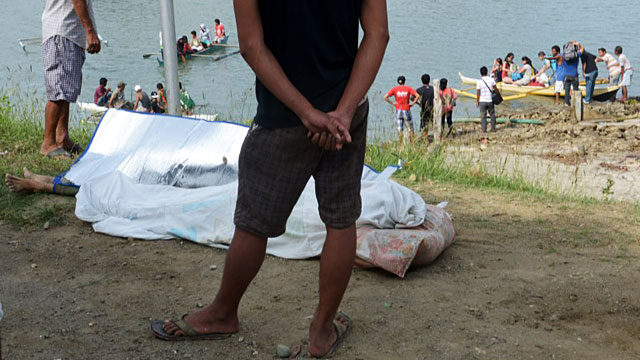SUMMARY
This is AI generated summarization, which may have errors. For context, always refer to the full article.

MANILA, Philippines (UPDATED) – Two towns in Bohol hardest hit by the 7.2-magnitude earthquake remained isolated on Wednesday, October 16, with damaged bridges and roads delaying, if not preventing, rescue and relief efforts.
In a briefing on Wednesday afternoon, October 16, the National Disaster Risk Reduction Council (NDRRC) said impassable roads and bridges have made post-quake efforts difficult, even as the number of fatalities in Central Visayas rose to 144, with 291 others injured. There are still 23 missing persons, all in Bohol.
Most of the fatalities are in Bohol, where the quake ripped apart bridges, tore down centuries-old churches, and triggered landslides that engulfed entire homes.
Loon and Maribojoc towns in Bohol are totally isolated. Relief goods can only be brought by boat. For other localities, like Tagbilaran City, people have to bring relief goods by foot.
Twenty-three roads in the province are damaged while 5 are impassable. Eighteen bridges are impassable and 3 are collapsing. In Cebu, 7 bridges are partially damaged while 2 fly-overs are partially damaged but are passable.
Estimates for the cost of damaged roads, bridges and flood control infrastructure are at P75.15 million. Of this, P57.5 million is the cost of damage in Bohol. Cost of damage in Cebu is at P17.65 million.
“We’re trying our best to keep hopes up, but in this desperate situation there is nothing much we can do beyond giving comforting words,” Father Tomas Balakayo, a priest, told Agence France-Presse as he stood in front of Loon’s destroyed limestone church.
“I try to be strong but this is terrible, what have these people done to deserve this?”
Loon, a small coastal town of about 40,000 people, sits 20 kilometers from the epicenter of the earthquake. Its shocked survivors used their bare hands to scour through the rubble of their homes.
Loon farmer Serafin Megallen said he dug with his hands, brick-by-brick, to retrieve his mother-in-law and cousin from the rubble of their home on Tuesday.
“They were alive, but they died of their injuries 3 hours later. There was no rescue that came, we had to rely on neighbors for help,” he told Agence France-Presse.
Loon was one of the most badly affected communities, with 42 people confirmed killed there so far, according to Bohol police chief Senior Superintendent Dennis Agustin.
But for most of Wednesday the only people involved in the search and rescue efforts were local residents and police, with only a few rescue workers arriving by boat, and no heavy equipment that could have plied through the rubble.
Four people were believed to have been inside Loon’s Our Lady of Light church when it collapsed, according to Balakayo, the priest.
He said they remained unaccounted for, but locals had given up hope they were still alive.
In front of the rubble of the church an improvised altar had been erected with a lone statue of the Virgin Mary, where teary residents stopped by to make the sign of the cross.
Survivors were further tormented on Wednesday by incessant aftershocks, including some exceeding 5.1, according to national disaster authorities.
President Benigno Aquino III visited Bohol and Cebu to oversee rescue efforts, and sought to reassure survivors as the number of aftershocks surpassed 800.
Relief efforts
According to the Department of Social Welfare and Development (DSWD), 593,561 families or 3,017,814 persons so far have been affected by the disaster. In Bohol, 34 evacuation centers hold 5,670 families or 28,100 persons.
The agency said it released an additional P10 million for Region 7 to purchase additional supplies.
On Wednesday morning, C130 planes flew in 2,000 food packs and 100 rolls of laminated plastic sheets, which evacuees can use as temporary tents. More supplies were loaded on a Philippine Coast Guard ship, including 8,000 family food packs and 1,000 boxes of drinks. These supplies will reach Bohol and Cebu on October 19 or 20.
Repacking of more supplies is ongoing at the DSWD office in Metro Manila.
Nineteen houses were reported to be totally damaged, while 284 are partially damaged. DSWD expects these numbers to rise as validation continues.
The Department of Education reported that a total of 30 schools in Bohol and Cebu were damaged. Classes in Bohol, Tagbilaran City, Cebu City, and Dumaguete City are suspended until Friday, October 18. Classes in La Carlota City in Negros Occidental and Iloilo will resume tomorrow, October 17. (READ: Class suspensions: Thursday, October 17)
At of 2:25pm on October 16, the National Grid Corporation of the Philippines (NGCP) said it had “fully restored use of power supply sites in Bohol.” It said no sites were damaged in Cebu.
Meanwhile, National Telecommunications Commission Director Edgardo Cabarios said that as of noon of Wednesday, Smart and Sun cell sites were fully operational. Out of 64 2G sites owned by Globe, 23 have been restored; for 3G sites, 33 out of 63 have been restored.
Enough rice and oil
Department of Trade and Industry Director Aster Caberte gave assurances that there was enough rice to last the province of Bohol for 30 days .
The DPWH and DTI are coordinating with each other to find alternative routes so that the rice supplies could be transported from Ubay town in Bohol to all affected areas.
Bohol’s petroleum supply is good for 8 weeks, said Caberte.
President Benigno Aquino III, during his visit to Bohol on Wednesday, reiterated what he said on the day of the disaster – that it is a chance to improve the country’s ability to respond to disaster.
“I really want to assure everybody, everytime there’s a natural calamity – even a man-made calamity – and every time a life is lost, it really presses us further to find how we can further improve what is already existing.”
He also expressed gratitude for the quick response of many Filipinos.
“Thank you for everybody’s quick response…. We have to look for ways and means how we can be of service faster, quicker, and more effectively.” – with reports from Agence France-Presse/Rappler.com
Add a comment
How does this make you feel?





There are no comments yet. Add your comment to start the conversation.